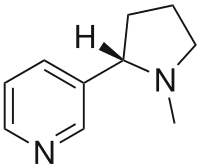
Photo from wikipedia
Background There are no therapies shown to improve outcome after severe traumatic brain injury (TBI) in humans, a leading cause of morbidity and mortality. We sought to verify brain exposure… Click to show full abstract
Background There are no therapies shown to improve outcome after severe traumatic brain injury (TBI) in humans, a leading cause of morbidity and mortality. We sought to verify brain exposure of the systemically administered antioxidant N-acetylcysteine (NAC) and the synergistic adjuvant probenecid, and identify adverse effects of this drug combination after severe TBI in children. Methods IRB-approved, randomized, double-blind, placebo controlled Phase I study in children 2 to 18 years-of-age admitted to a Pediatric Intensive Care Unit after severe TBI (Glasgow Coma Scale [GCS] score ≤8) requiring an externalized ventricular drain for measurement of intracranial pressure (ICP). Patients were recruited from November 2011-August 2013. Fourteen patients (n = 7/group) were randomly assigned after obtaining informed consent to receive probenecid (25 mg/kg load, then 10 mg/kg/dose q6h×11 doses) and NAC (140 mg/kg load, then 70 mg/kg/dose q4h×17 doses), or placebos via naso/orogastric tube. Serum and CSF samples were drawn pre-bolus and 1–96 h after randomization and drug concentrations were measured via UPLC-MS/MS. Glasgow Outcome Scale (GOS) score was assessed at 3 months. Results There were no adverse events attributable to drug treatment. One patient in the placebo group was withdrawn due to adverse effects. In the treatment group, NAC concentrations ranged from 16,977.3±2,212.3 to 16,786.1±3,285.3 in serum and from 269.3±113.0 to 467.9±262.7 ng/mL in CSF, at 24 to 72 h post-bolus, respectively; and probenecid concentrations ranged from 75.4.3±10.0 to 52.9±25.8 in serum and 5.4±1.0 to 4.6±2.1 μg/mL in CSF, at 24 to 72 h post-bolus, respectively (mean±SEM). Temperature, mean arterial pressure, ICP, use of ICP-directed therapies, surveillance serum brain injury biomarkers, and GOS at 3 months were not different between groups. Conclusions Treatment resulted in detectable concentrations of NAC and probenecid in CSF and was not associated with undesirable effects after TBI in children. Trial registration ClinicalTrials.gov NCT01322009
Journal Title: PLoS ONE
Year Published: 2017
Link to full text (if available)
Share on Social Media: Sign Up to like & get
recommendations!